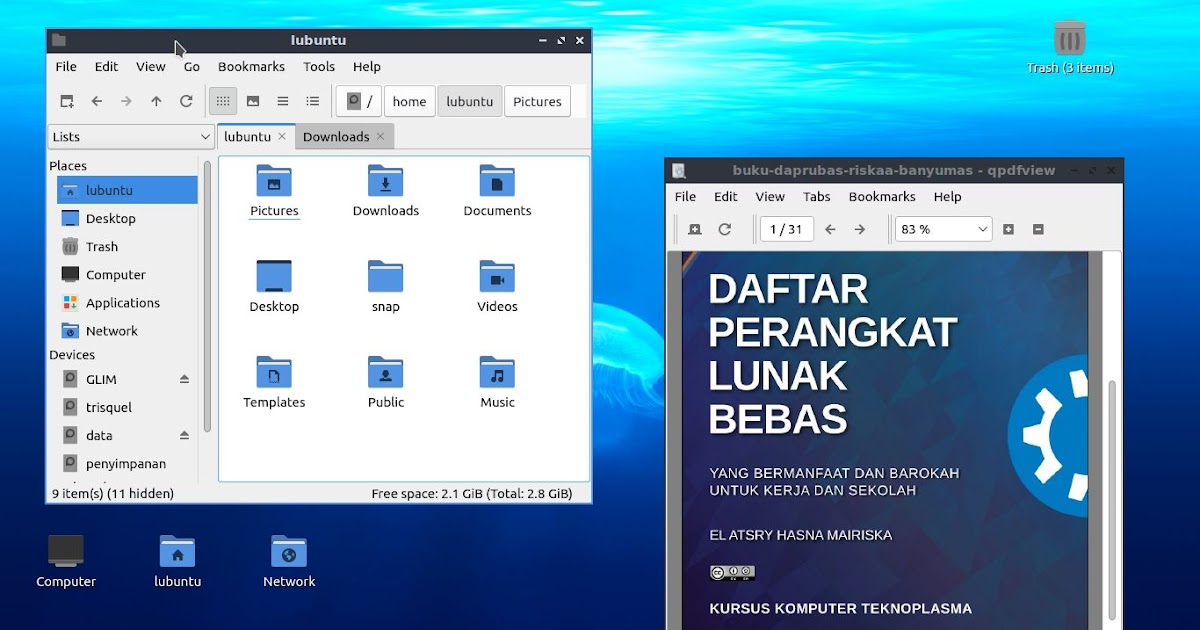A Complete Guide to Lubuntu Default Apps and Their Purposes
This is a full list of all Lubuntu default applications (or list
of Lubuntu components) with their explanations for first time users. Lubuntu is the official variant of Ubuntu with LXDE as the technology of the desktop environment and default applications. This
list is sorted alphabetically with app names taken from menu for example Discover, FeatherPad and PCManFM. You can learn your Lubuntu computer a lot here as you see every app
name, its purpose, short guide to use, and some pictures of them. This guide is
based on version 22.04 also known as Jammy Jellyfish which can represents all modern Lubuntu versions. Let’s read. We wish you’ll love it!
Subscribe to UbuntuBuzz Telegram Channel to get article updates.
The software installation place. Discover’s purpose is to serve user to find, install, update and remove every one of applications and games and the whole system in graphical mode.
The text editor. FeatherPad’s purpose is for text editing such as writing plain text notes, articles, even stories and programming codes. One can say it is the Notepad of Lubuntu.
The web browser. Firefox’s purpose is for all web browsing and watching online video streams not different to everything user can do with Chrome or Internet Explorer. It is modern and extensible with tens of thousands add-ons commonly used by its millions of users.
Lightweight X11 Desktop Environment (LXDE) is the name of the user interface technology used in Lubuntu and the origin of the Lubuntu name itself.
(Image source: Wikipedia LXDE and Wikimedia Commons LXDE)
LXDE Qt (LXQt) is the new generation of the Lubuntu desktop environment built using Qt technology instead of the old GTK. It is the current user interface of Lubuntu and thus now LXDE became legacy.
Qt (pronounced “cute”) is the programming technology used to develop KDE as desktop environment and Kubuntu as operating system and in context of Lubuntu it is used to rebuilt LXDE anew into LXQt. Today, Lubuntu is based on Qt instead of the old GTK.
The
file manager. All user activities on Lubuntu are centered in PCManFM.
It is small and fast and its purpose is to serve user all file management tasks and everything related to accessing files in disk drives. The name comes
from the nickname of the author of LXDE Hong Jen Yee (“PCMan”) and its
FM stands for “file manager.”
The word processor. Writer’s purpose is, like Word, for writing formatted text documents such as books, brochures, letters which can be printed out as well as exported to as many digital formats as possible. On Lubuntu, it comes with free software fonts built-in such as Liberation and Nimbus as replacements to the nonfree (proprietary) ones. It has abilities to read and write documents in multiple formats including Microsoft Word 2003/2007 and OpenDocument Formats.
The spreadsheet. Calc’s purpose is, like Excel, for writing spreadsheet documents and calculating data such as charts and statistics which can be printed out as well as
exported to as many digital formats as possible. On Lubuntu, it comes
with free software fonts built-in such as FreeSerif and Nimbus Sans as
replacements to the nonfree (proprietary) Times and Arial. It has abilities to read
and write documents in multiple formats including Microsoft Excel
2003/2007 and OpenDocument Formats.
The multipurpose diagram editor. Draw’s purpose is, like CorelDRAW and Visio, for drawing vector graphics, making diagrams and flowcharts as well as editing PDF documents. It has abilities to open both CorelDRAW’s CDR and Visio’s VSD as well as Scalable Vector Graphics (SVG) –a drawing format now popular used with Inkscape– and write to ODG (OpenDocument Drawing) and PDF.
The presentation (keynote) tool. Impress’s purpose is, like PowerPoint, for writing impressive presentation documents which can be printed out
as well as
exported to as many digital formats as possible. On Lubuntu, it comes
with free software fonts built-in for almost all countries’ writing scripts including Arabic, Japanese, Chinese and Korean. It has
abilities to read
and write documents in multiple formats including Microsoft PowerPoint
2003/2007 and OpenDocument Formats.
The image viewer. Its purpose is to quickly show photos and pictures.
The software installation place with more details. Muon’s purpose is to serve user for installing, removing, updating software packages in their Lubuntu system in detailed mode. It is a companion to Discover.
The pdf reader with multitab features. Its purpose is to read PDF documents quickly. Its features other than standard ones including invert color, bookmarks and presentation mode.
The traditional group chat (IRC Client) application. Its purpose is to serve user joining Lubuntu users and developers official group chat (#lubuntu) as well as other group chats available on the net.
The screenshot tool. Its purpose is to take screenshot of Lubuntu desktop either it is fullscreen or parts of it with or without delay time.
The scanner utility. Its purpose is to detect, configure and help user scan their paper documents using a scanner device.
The high-speed download/upload manager (BitTorrent client). Its purpose is mainly for helping user download large sized files freely available on the internet as torrents (movies, oses, applications, games etc) as well as upload files in peer-to-peer mode. Lubuntu itself is officially made available as torrents and any version can be downloaded by using Transmission.
The video player. Its purpose is playing both movies and musics. It has a complete set of features from the standard to the advanced ones such as encoding multimedia files from one format to another like from mp4 to mp3.
****
****
This article is licensed under CC BY-SA 3.0.

















